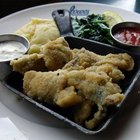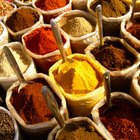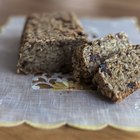
MariuszSzczygiel/iStock/Getty Images
Breaded food has a satisfying crunchy texture when used as a coating on baked or fried foods or as a topping on casseroles. Saltine crackers, sometimes recommended for breading, easily provide the crunch but are high in salt. Too much sodium in the diet can contribute to high blood pressure, heart disease and other illnesses. Breadcrumbs provide a healthier alternative for breaded foods, particularly when they are whole-grain.
Crackers vs. Breadcrumbs
Some recipes use saltines for breading due to their simplicity; crackers require only crushing, but breadcrumbs may require more preparation, especially if homemade. Crackers are already preseasoned and flavorful, but breadcrumbs may be bland if seasonings are not added. They also may not develop the same crisp coating as crackers if they aren't suitably dried before use. Purchased breadcrumbs save you the work of making your own, but they may contain high sodium and fat. Check the label before buying.
Whole-Grain Benefits
The main benefit of using breadcrumbs, other than the lower sodium content, is the option to use whole grains. Whole-grain bread provides all the nutritive benefits of the grain used, including B vitamins, fiber and antioxidants. A bread containing a variety of grains and seeds works especially well for breading because the different grains provide more flavor without the need for salt. For example, seed breads retain a nutty flavor that may be the perfect complement to your dish.
Considerations
The texture of breadcrumbs depends on their size and how dry they are. Cubed bread, baked at a low temperature for 10 to 15 minutes, becomes dry but not burned. Day-old bread and bread heels work especially well because they have already begun to dry naturally. Running the oven-dried breadcrumbs through a food processor or blender before use creates a finer-textured, almost powdery crumb that provides optimum crunch. When used as a topping on a casserole, larger crumbs absorb more moisture and may not develop as much crunch. Celery seed adds a salty flavor to breadcrumbs, and thyme, sage and pepper work well with most foods. Experiment with your favorite herbs when seasoning breadcrumbs.
Cooking Techniques
Breaded foods are often fried in oil, which adds fat to the meal. Breadcrumbs may also develop a soggy texture when immersed in oil. Pan frying in a small amount of a healthy oil, such as olive oil, provides a suitable preparation method for some foods, including thin cuts of chicken and fish. To avoid oil altogether, bake the breaded food in the oven, using a cooking spray if needed. The breadcrumbs still become crisp and crunchy, but the food won't be greasy.
Related Articles

How to Use Panko

How to Turn Plain Bread Crumbs Into ...
What Is Panko Flour?

Frying With Flour, Eggs and Bread Crumbs

What Is Indian Flatbread Called?

Whole Wheat Pastry: Flour Substitutions

How to Make Communion Bread Wafers
How to Substitute Quinoa for Breadcrumbs
What Is Rusk Bread?
How Long Do You Bake Veal Cutlets?

Can You Substitute Anything for Egg Dip ...

Buttery Round Cracker Substitute

How to Coat Pork Chops With Breadcrumbs

Can You Bread Chicken Wings With Egg ...

How to Eat Fennel Seeds

Good Ways to Cook Drumsticks in an Oven ...

Does Unbleached Bread Flour Make ...

What Kind of Bread Do I Serve With ...

How to Add Gluten to All-Purpose Flour

Gluten-Free Bread Without Eggs
References
Writer Bio
Jenny Harrington has been a freelance writer since 2006. Her published articles have appeared in various print and online publications. Previously, she owned her own business, selling handmade items online, wholesale and at crafts fairs. Harrington's specialties include small business information, crafting, decorating and gardening.
Photo Credits
MariuszSzczygiel/iStock/Getty Images